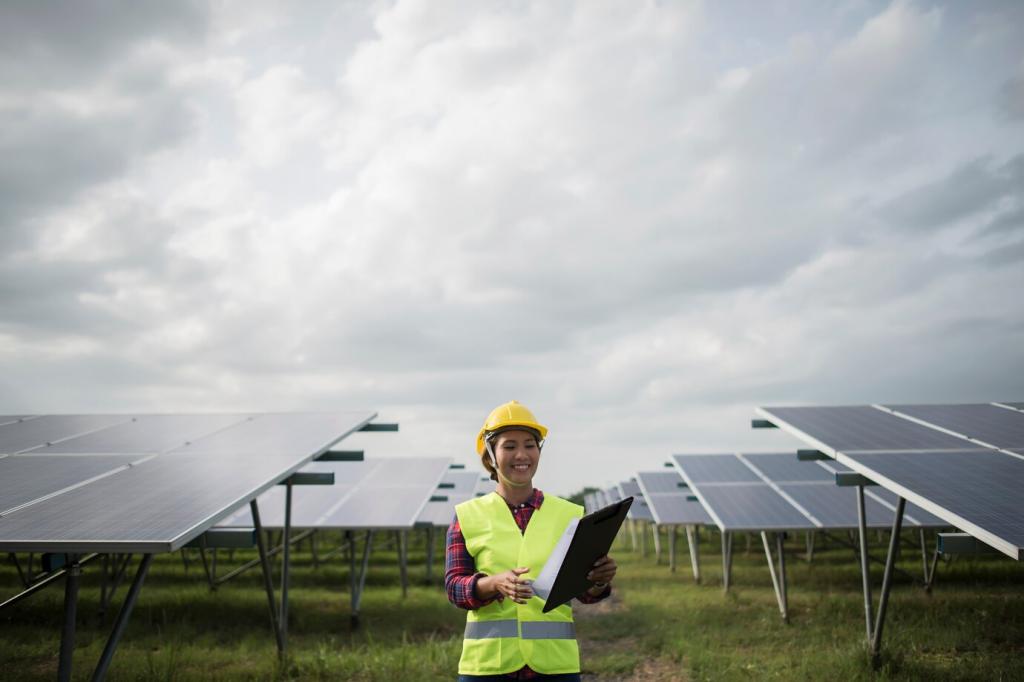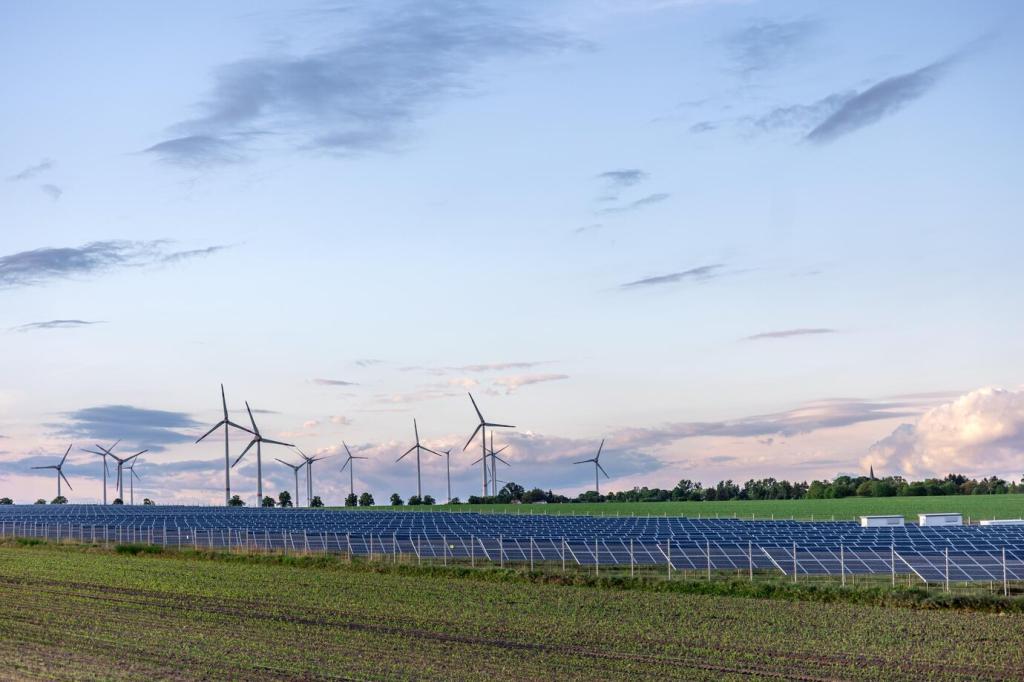Solar energy harvesting has experienced remarkable advancements over the past decade, changing the way we generate and consume power. Emerging technologies, innovative materials, and smart integration methods are expanding the potential of solar energy far beyond traditional photovoltaic panels on rooftops. This page explores the latest achievements in the field, highlighting how innovations are addressing efficiency, accessibility, and the integration of solar technologies into everyday life and large-scale infrastructures.
Next-Generation Photovoltaic Materials
Perovskite Solar Cells
Perovskite materials have emerged as highly promising candidates in the solar industry. Their unique crystal structure allows them to absorb light very efficiently, and they can be manufactured using low-cost methods compared to silicon. While early perovskite cells showed stability issues, recent breakthroughs in formulations and encapsulation techniques have significantly improved their durability. This progress has not only paved the way for commercial production but also opened opportunities for lightweight, flexible panels perfect for integration into new urban environments. The advancement of perovskite-based cells suggests a future where solar energy can be harvested from virtually any surface, expanding possibilities for both residential and commercial applications.
Organic Photovoltaic Technologies
Organic photovoltaics (OPVs), built from carbon-based materials, offer a new horizon in solar technology. These flexible, lightweight cells can be fabricated using roll-to-roll processing, much like printing newspapers. This production capability dramatically reduces the cost and resources needed to deploy solar panels, especially over large areas or unconventional surfaces. While OPVs traditionally trailed silicon-based cells in efficiency, steady improvements in molecular design and layering have yielded significant gains. Their inherent transparency further allows their use in windows and facades, creating possibilities for building-integrated photovoltaics that generate power unobtrusively while doubling as part of architectural design.
Quantum Dot Solar Cells
Quantum dots are nanometer-scale semiconductor particles that can be tuned to absorb and emit specific wavelengths of light. By manipulating their size and composition, researchers can engineer quantum dot solar cells to capture more of the solar spectrum than conventional materials. This tunability promises record-setting efficiencies and performance in low-light conditions, which is a significant advantage for northern latitudes or overcast climates. Recent work focuses on improving the environmental safety and scalability of quantum dot manufacturing processes, pushing this technology closer to commercial reality and possibly redefining the potential maximum energy conversion rates of solar cells.

Bifacial panels capture sunlight from both sides, utilizing reflected light from rooftops, ground, or nearby surfaces. This design improves the total energy yield compared to monofacial modules, without significantly increasing the installation footprint. As materials and panel transparency have advanced, bifacial modules have become robust and cost-effective, making them attractive for utility-scale installations as well as urban projects where maximizing output per square meter is desirable. Ongoing developments in tracking systems and surface coatings continue to enhance their performance, providing a viable option for both retrofitting existing sites and designing new solar farms.

BIPV merges electricity generation with construction elements by integrating solar energy devices directly into building materials such as façades, skylights, and windows. This approach transforms architectural surfaces into energy-producing assets, reducing the need for separate panel installations and preserving design aesthetics. Recent advances in semi-transparent and patterned photovoltaic cells allow architects to incorporate solar technology creatively and unobtrusively. BIPV is gaining momentum not only for its innovative use of space but also for its potential to contribute to green building standards and urban sustainability, especially as cities seek resilient, decentralized power solutions.

Emerging thin-film and polymer technologies have enabled the creation of lightweight, bendable solar panels. These panels can adhere directly to irregular surfaces such as vehicles, tents, or curved building roofs—previously impractical for rigid silicon panels. Applications in emergency shelters, portable power systems, and even wearables showcase the versatility of these innovations. With ongoing improvements in durability and efficiency, these flexible solar products are making solar energy more accessible, mobile, and adaptable to a range of scenarios, further broadening the impact and reach of solar harvesting technology.

Enhanced Solar Tracking Systems
Single-axis trackers follow the sun’s movement from east to west, allowing solar arrays to maintain a favorable angle throughout the day. These systems are increasingly common in large-scale solar farms, thanks to robust engineering and falling costs. By boosting daily energy yields by 10–25% compared to fixed panels, they improve the return on investment for utility operators. New models are designed to withstand harsh weather events and adapt to varied terrains, further expanding their deployment. As solar becomes a backbone of the renewable power grid, single-axis trackers will continue to play a vital role in maximizing clean energy production.
Previous
Next

Advanced Metering Infrastructure
Advanced metering allows utilities and consumers to monitor electricity usage and solar generation in real-time. These smart meters provide detailed consumption data, enabling dynamic pricing, demand-response measures, and easier integration of home solar systems into the grid. Enhanced data granularity supports utilities in making informed decisions regarding energy flow, load-balancing, and storage deployment. For consumers, this level of transparency encourages energy efficiency and informed participation in energy markets, driving a more democratic and efficient energy landscape.
Automated Demand Response
Automated demand response systems work alongside solar harvesting by temporarily adjusting electricity usage in response to grid needs. When solar production is highest, smart appliances and building systems can be triggered to consume more power, reducing the need for fossil generation and stabilizing voltage. These systems employ algorithms and communications protocols to coordinate with solar generation patterns, providing automatic, near-instant responses to grid signals. The widespread implementation of automated demand response is a key factor in enabling high-penetration renewables and mitigating fluctuations inherent to solar resources.
Distributed Energy Resource Management Systems (DERMS)
DERMS platforms oversee a diverse mix of solar panels, batteries, and other distributed resources to optimize grid reliability and efficiency. By using sensors, analytics, and controls, these systems manage local generation and consumption, identify congestion, and help prevent blackouts. As the number of solar-powered homes, businesses, and microgrids rises, the orchestration provided by DERMS ensures that power flows smoothly and sustainably across networked communities. These innovations, supported by the latest in software and telecommunications, are fundamental for future-proofing the grid as solar adoption accelerates.

Vertical Solar Installations
Urban spaces often lack traditional roof or ground space for large solar arrays, driving the innovation of vertical solar solutions on the sides of buildings. New mounting systems and advanced panel designs make it possible to install efficient solar facades that capture sunlight reflected from surrounding structures or roads. These installations take advantage of underutilized vertical surfaces, transforming city skylines into energy producers and reducing urban heat island effects. With rising demand for local, resilient power in dense cities, vertical solar offers a blueprint for high-impact clean energy integration in metropolitan environments.

Off-Grid Solar Systems for Rural Electrification
In rural and remote areas with limited grid connectivity, standalone solar solutions provide a lifeline. Lightweight, modular solar kits and microgrids are bringing reliable electricity to communities previously reliant on expensive or polluting diesel generators. Innovations in battery storage, user-friendly interfaces, and mobile payment integration make these systems practical and sustainable for rural populations. Off-grid solar not only powers homes and businesses but also supports essential services such as healthcare, telecommunications, and education, reinforcing the role of solar energy as a driver of inclusive development.
Improvements in Solar Efficiency and Longevity
Dust, dirt, and reflective losses can significantly reduce solar panel performance. Scientists have developed specialized coatings that repel particles and water, mimicking lotus leaves’ self-cleaning abilities and reducing the need for manual washing. Anti-reflective layers improve light absorption, boosting output without altering panel structure or adding major costs. These innovations extend maintenance intervals, decrease water usage—especially crucial in arid regions—and help keep panels operating at peak efficiency. With continued advances, such coatings are expected to become a standard component in panel manufacturing worldwide.
High operating temperatures degrade solar cell performance and longevity. Modern solar panels often integrate passive or active thermal management features, such as heat sinks, phase-change materials, or micro-channel water cooling. These enhancements stabilize cell temperatures, minimize efficiency loss during hot weather, and extend overall equipment life. Research into next-generation materials and cooling designs is further improving panel resilience under extreme conditions. These improvements not only increase power yield but also reduce the lifetime cost of solar assets, supporting greater investment in renewable infrastructure.
The adoption of sensors, wireless connectivity, and cloud-based data systems allows for comprehensive, real-time monitoring of solar installations. Operators can rapidly detect faults, identify performance dips, and initiate predictive maintenance before small issues become major failures. Data analytics help optimize daily energy harvest based on weather, shading, and panel orientation. For large arrays, fleet-wide monitoring platforms contribute to both reduced downtime and increased long-term system performance. As monitoring technology becomes universal, the reliability and output of solar systems will set new benchmarks for the industry.

Emerging Applications and Future Trends
Solar panels are increasingly being integrated into electric vehicles, trains, and boats, providing supplementary power and extending range. Innovations in lightweight, high-efficiency panels make it possible to embed solar cells into car roofs, trailers, or even entire fleets of urban buses. Solar airports and transportation hubs, where vast roof spaces can become energy assets, further underline aviation’s shift toward sustainability. As electric mobility advances, the synergies between solar and transportation will accelerate, offering cleaner journeys with reduced reliance on conventional charging infrastructure.

